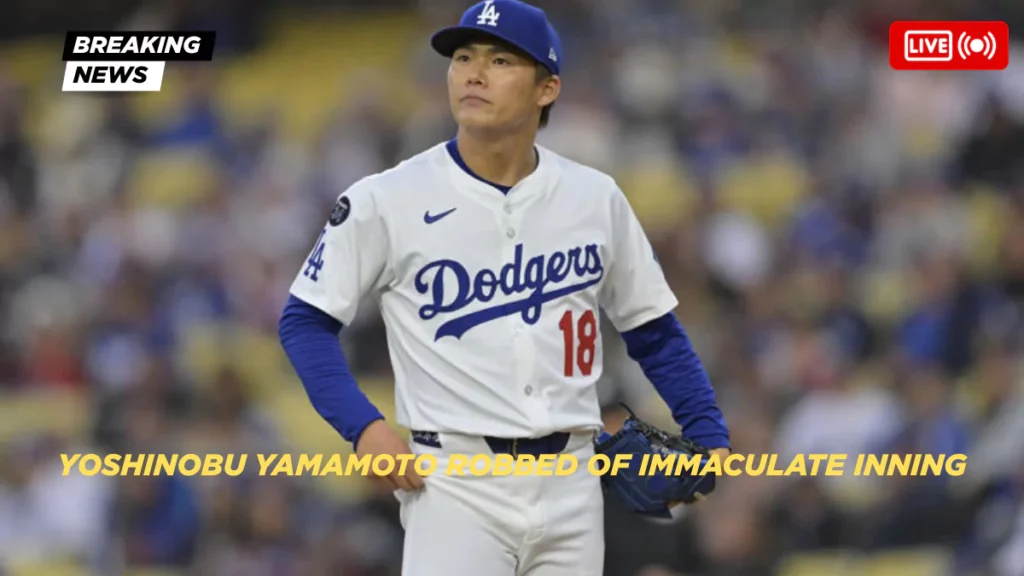Yoshinobu Yamamoto Robbed of Immaculate Inning by Umpire’s Egregious Call in 2025 Dodgers-Padres Clash
Did a single call just rewrite baseball history? On June 19, 2025, Los Angeles Dodgers star pitcher Yoshinobu Yamamoto was one pitch away from etching his name into MLB’s rarest records—an immaculate inning, a feat achieved only 118 times in league history.
Facing the San Diego Padres, Yamamoto’s perfect 0-2 fastball to Fernando Tatis Jr. screamed “strike three,” but home plate umpire Marvin Hudson called it a ball, sparking outrage among fans and analysts. This article dives into the controversial moment, its impact, and the growing call for automated umpiring.

What Is an Immaculate Inning, and Why Is It So Rare?
Defining the Feat
An immaculate inning occurs when a pitcher strikes out three batters in a single inning using just nine pitches—each a strike. It’s a display of pinpoint precision and dominance, rarer than a no-hitter, with only 118 recorded in MLB history compared to 326 no-hitters.
Legends like Sandy Koufax, Chris Sale, and Max Scherzer are among the few with multiple immaculate innings, highlighting the exclusivity of this club.
The 2025 Context
This season, only one immaculate inning has been recorded, by Miami Marlins’ Cal Quantrill on May 18. Yamamoto’s near-miss would have made him the second pitcher in 2025 to achieve this, cementing his status as a Dodgers ace.
The Moment That Shocked Dodger Stadium
Yamamoto’s Dominant Third Inning
In the top of the third inning against the San Diego Padres, Yamamoto was in top form. He struck out Bryce Johnson on three pitches, followed by Martín Maldonado on three more, both with surgical efficiency.
Facing Fernando Tatis Jr., a dangerous hitter, Yamamoto got ahead 0-2 with two strikes. His ninth pitch—a 96 mph fastball—sailed down the middle of the strike zone. Fans erupted, expecting the call that would seal an immaculate inning.
The Call That Changed Everything
Shockingly, home plate umpire Marvin Hudson called the pitch a ball. Replays and pitch-tracking data confirmed the pitch was squarely in the strike zone, with commentators like Joe Davis exclaiming, “Marvin Hudson cost him an immaculate inning!”
Padres broadcasters Don Orsillo and Tony Gwynn Jr. agreed, noting the pitch was “borderline middle-middle.” The call left Yamamoto settling for an 11-pitch, three-strikeout inning after striking out Tatis two pitches later.
Fan and Analyst Reactions: Outrage and Calls for Change
Social Media Erupts
The missed call ignited a firestorm on X, with fans across team allegiances expressing disbelief. One user posted, “Robot umps now. Human error cost history tonight,” while another lamented, “I was cheering for the immaculate, then had to explain to my 6-year-old why we stopped celebrating.” Even Padres fans admitted the call was “egregious,” with one stating, “Man, f*** the Dodgers, but I hate this as a fan of the game.”
Broadcasters Weigh In
Dodgers announcer Joe Davis called it a “bummer,” jokingly asking for automated ball-strike (ABS) systems from Triple-A. Padres’ Tony Gwynn Jr. was stunned, expecting the pitch to be high but seeing it was “right in the middle.” The consensus was clear: the call was a historic blunder.
The Case for Robot Umpires
A Growing Debate
This incident has fueled the ongoing debate over automated umpiring systems. With pitch-tracking technology exposing errors in real-time, calls like Hudson’s amplify demands for ABS. Fans on Reddit argued, “The umps are making the strongest case for robot umps themselves,” citing the precision of modern systems, which could achieve “98-99% effectiveness.” However, skeptics worry about over-reliance on tech, pointing to flaws in other AI-driven systems like self-driving cars.
MLB’s Stance
MLB has experimented with ABS in the minors, but the umpires’ union and concerns about game flow have slowed adoption. Hudson, a 27-year veteran, has faced criticism for inconsistent strike zones before, including in playoff games, making this call a flashpoint in the debate.
Visual Suggestion: Include an image of an ABS system interface from a minor league game. Alt Text: “Automated Ball-Strike system interface used in minor league baseball, relevant to 2025 debate over umpire calls in MLB.”
Yamamoto’s Stellar 2025 Season
A Rising Star
Despite the missed call, Yamamoto’s performance underscores his role as the Dodgers’ ace. In 2025, he boasts the second-best ERA in the National League (1.86) and has delivered standout performances, including a no-hitter bid into the seventh inning against the Arizona Diamondbacks on May 21. His consistency, even amid the Dodgers’ injury-plagued rotation, makes this missed opportunity sting even more.
What Could Have Been
Had the call gone Yamamoto’s way, he would have joined an elite group of pitchers, potentially boosting his legacy in his second MLB season. The Dodgers, battling in a tight NL West race, rely on Yamamoto’s dominance, but this moment highlights how human error can overshadow brilliance.
Visual Suggestion: Feature a high-resolution action shot of Yamamoto pitching. Alt Text: “Yoshinobu Yamamoto pitching for the Los Angeles Dodgers in 2025, moments before a controversial umpire call denied his immaculate inning.”
What’s Next for Yamamoto and the Dodgers?
Upcoming Challenges
The Dodgers face a critical series against the Padres, with Yamamoto likely to take the mound again soon. His ability to shrug off this setback will be key in a division race where every game counts. Manager Dave Roberts praised Yamamoto’s composure, noting, “He’s our best option, and he proved it.”
The Bigger Picture
This incident may push MLB closer to adopting ABS, especially as fans and analysts demand fairness. For now, Yamamoto’s near-immaculate inning remains a “what-if” moment, but his 2025 season continues to solidify his status as a global star.
Stay Updated: Follow our MLB coverage for the latest on Yamamoto, the Dodgers, and the robot umpire debate. Share your thoughts on the call in the comments below!
Also Read:
Social Security Crisis Looms, Recipients Face 19% Benefit Cut by 2034




